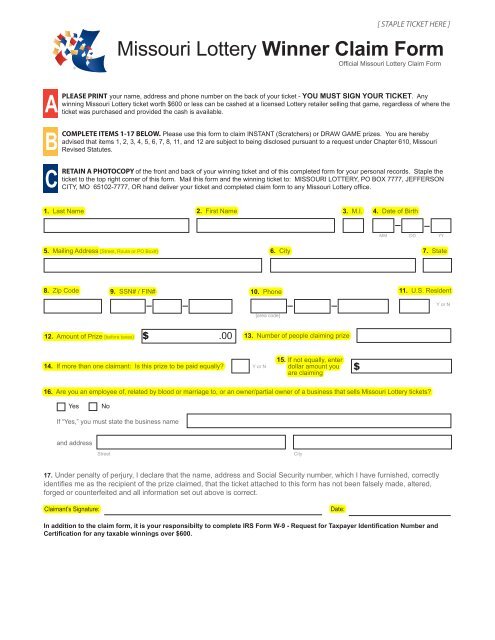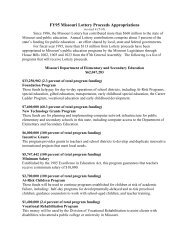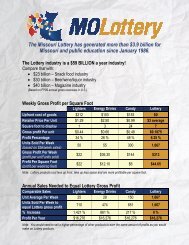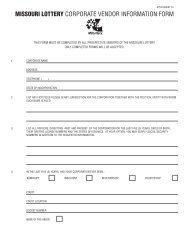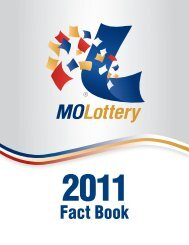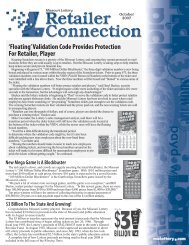Missouri Lottery Winner Claim Form
Missouri Lottery Winner Claim Form
Missouri Lottery Winner Claim Form
Create successful ePaper yourself
Turn your PDF publications into a flip-book with our unique Google optimized e-Paper software.
A<br />
B<br />
C<br />
[ STAPLE TICKET HERE ]<br />
<strong>Missouri</strong> <strong>Lottery</strong> <strong>Winner</strong> <strong>Claim</strong> <strong>Form</strong><br />
PLEASE PRINT your name, address and phone number on the back of your ticket - YOU MUST SIGN YOUR TICKET. Any<br />
winning <strong>Missouri</strong> <strong>Lottery</strong> ticket worth $600 or less can be cashed at a licensed <strong>Lottery</strong> retailer selling that game, regardless of where the<br />
ticket was purchased and provided the cash is available.<br />
COMPLETE ITEMS 1-17 BELOW. Please use this form to claim INSTANT (Scratchers) or DRAW GAME prizes. You are hereby<br />
advised that items 1, 2, 3, 4, 5, 6, 7, 8, 11, and 12 are subject to being disclosed pursuant to a request under Chapter 610, <strong>Missouri</strong><br />
Revised Statutes.<br />
RETAIN A PHOTOCOPY of the front and back of your winning ticket and of this completed form for your personal records. Staple the<br />
ticket to the top right corner of this form. Mail this form and the winning ticket to: MISSOURI LOTTERY, PO BOX 7777, JEFFERSON<br />
CITY, MO 65102-7777, OR hand deliver your ticket and completed claim form to any <strong>Missouri</strong> <strong>Lottery</strong> office.<br />
1. Last Name 2. First Name 3. M.I. 4. Date of Birth<br />
5. Mailing Address [Street, Route or PO Box#] 6. City 7. State<br />
8. Zip Code 9. SSN# / FIN# 10. Phone 11. U.S. Resident<br />
12. Amount of Prize [before taxes]<br />
[area code]<br />
16. Are you an employee of, related by blood or marriage to, or an owner/partial owner of a business that sells <strong>Missouri</strong> <strong>Lottery</strong> tickets?<br />
Street<br />
$<br />
17. Under penalty of perjury, I declare that the name, address and Social Security number, which I have furnished, correctly<br />
identifies me as the recipient of the prize claimed, that the ticket attached to this form has not been falsely made, altered,<br />
forged or counterfeited and all information set out above is correct.<br />
<strong>Claim</strong>ant’s Signature: Date:<br />
.00<br />
14. If more than one claimant: Is this prize to be paid equally? Y or N<br />
Yes No<br />
If “Yes,” you must state the business name<br />
and address<br />
13. Number of people claiming prize<br />
Official <strong>Missouri</strong> <strong>Lottery</strong> <strong>Claim</strong> <strong>Form</strong><br />
In addition to the claim form, it is your responsibilty to complete IRS <strong>Form</strong> W-9 - Request for Taxpayer Identification Number and<br />
Certification for any taxable winnings over $600.<br />
15.<br />
If not equally, enter<br />
dollar amount you<br />
are claiming<br />
City<br />
$<br />
MM<br />
DD YY<br />
Y or N
<strong>Form</strong> W-9 Request for Taxpayer<br />
(Rev. January 2003)<br />
Identification Number and Certification<br />
Department of the Treasury<br />
Internal Revenue Service<br />
Print or type<br />
See Specific Instructions on page 2.<br />
Part I<br />
Name<br />
Address (number, street, and apt. or suite no.)<br />
City, state, and ZIP code<br />
List account number(s) here (optional)<br />
Taxpayer Identification Number (TIN)<br />
Enter your TIN in the appropriate box. For individuals, this is your social security number (SSN).<br />
However, for a resident alien, sole proprietor, or disregarded entity, see the Part I instructions on<br />
page 3. For other entities, it is your employer identification number (EIN). If you do not have a number,<br />
see How to get a TIN on page 3.<br />
Social security number<br />
– –<br />
Give form to the<br />
requester. Do not<br />
send to the IRS.<br />
Requester’s name and address (optional)<br />
Note: If the account is in more than one name, see the chart on page 4 for guidelines on whose number Employer identification number<br />
to enter. –<br />
Part II<br />
Certification<br />
Under penalties of perjury, I certify that:<br />
1. The number shown on this form is my correct taxpayer identification number (or I am waiting for a number to be issued to me), and<br />
2. I am not subject to backup withholding because: (a) I am exempt from backup withholding, or (b) I have not been notified by the Internal<br />
Revenue Service (IRS) that I am subject to backup withholding as a result of a failure to report all interest or dividends, or (c) the IRS has<br />
notified me that I am no longer subject to backup withholding, and<br />
3. I am a U.S. person (including a U.S. resident alien).<br />
Certification instructions. You must cross out item 2 above if you have been notified by the IRS that you are currently subject to backup<br />
withholding because you have failed to report all interest and dividends on your tax return. For real estate transactions, item 2 does not apply.<br />
For mortgage interest paid, acquisition or abandonment of secured property, cancellation of debt, contributions to an individual retirement<br />
arrangement (IRA), and generally, payments other than interest and dividends, you are not required to sign the Certification, but you must<br />
provide your correct TIN. (See the instructions on page 4.)<br />
Sign<br />
Here<br />
Business name, if different from above<br />
Check appropriate box:<br />
Signature of<br />
U.S. person Date <br />
Purpose of <strong>Form</strong><br />
Individual/<br />
Sole proprietor Corporation Partnership Other <br />
A person who is required to file an information return with<br />
the IRS, must obtain your correct taxpayer identification<br />
number (TIN) to report, for example, income paid to you, real<br />
estate transactions, mortgage interest you paid, acquisition<br />
or abandonment of secured property, cancellation of debt, or<br />
contributions you made to an IRA.<br />
U.S. person. Use <strong>Form</strong> W-9 only if you are a U.S. person<br />
(including a resident alien), to provide your correct TIN to the<br />
person requesting it (the requester) and, when applicable, to:<br />
1. Certify that the TIN you are giving is correct (or you are<br />
waiting for a number to be issued),<br />
2. Certify that you are not subject to backup withholding,<br />
or<br />
3. <strong>Claim</strong> exemption from backup withholding if you are a<br />
U.S. exempt payee.<br />
Note: If a requester gives you a form other than <strong>Form</strong> W-9<br />
to request your TIN, you must use the requester’s form if it is<br />
substantially similar to this <strong>Form</strong> W-9.<br />
Foreign person. If you are a foreign person, use the<br />
appropriate <strong>Form</strong> W-8 (see Pub. 515, Withholding of Tax on<br />
Nonresident Aliens and Foreign Entities).<br />
Cat. No. 10231X<br />
Exempt from backup<br />
withholding<br />
Nonresident alien who becomes a resident alien.<br />
Generally, only a nonresident alien individual may use the<br />
terms of a tax treaty to reduce or eliminate U.S. tax on<br />
certain types of income. However, most tax treaties contain a<br />
provision known as a “saving clause.” Exceptions specified<br />
in the saving clause may permit an exemption from tax to<br />
continue for certain types of income even after the recipient<br />
has otherwise become a U.S. resident alien for tax purposes.<br />
If you are a U.S. resident alien who is relying on an<br />
exception contained in the saving clause of a tax treaty to<br />
claim an exemption from U.S. tax on certain types of income,<br />
you must attach a statement that specifies the following five<br />
items:<br />
1. The treaty country. Generally, this must be the same<br />
treaty under which you claimed exemption from tax as a<br />
nonresident alien.<br />
2. The treaty article addressing the income.<br />
3. The article number (or location) in the tax treaty that<br />
contains the saving clause and its exceptions.<br />
4. The type and amount of income that qualifies for the<br />
exemption from tax.<br />
5. Sufficient facts to justify the exemption from tax under<br />
the terms of the treaty article.<br />
or<br />
<strong>Form</strong> W-9 (Rev. 1-2003)
<strong>Form</strong> W-9 (Rev. 1-2003) Page 2<br />
Example. Article 20 of the U.S.-China income tax treaty<br />
allows an exemption from tax for scholarship income<br />
received by a Chinese student temporarily present in the<br />
United States. Under U.S. law, this student will become a<br />
resident alien for tax purposes if his or her stay in the United<br />
States exceeds 5 calendar years. However, paragraph 2 of<br />
the first Protocol to the U.S.-China treaty (dated April 30,<br />
1984) allows the provisions of Article 20 to continue to apply<br />
even after the Chinese student becomes a resident alien of<br />
the United States. A Chinese student who qualifies for this<br />
exception (under paragraph 2 of the first protocol) and is<br />
relying on this exception to claim an exemption from tax on<br />
his or her scholarship or fellowship income would attach to<br />
<strong>Form</strong> W-9 a statement that includes the information<br />
described above to support that exemption.<br />
If you are a nonresident alien or a foreign entity not<br />
subject to backup withholding, give the requester the<br />
appropriate completed <strong>Form</strong> W-8.<br />
What is backup withholding? Persons making certain<br />
payments to you must under certain conditions withhold and<br />
pay to the IRS 30% of such payments (29% after December<br />
31, 2003; 28% after December 31, 2005). This is called<br />
“backup withholding.” Payments that may be subject to<br />
backup withholding include interest, dividends, broker and<br />
barter exchange transactions, rents, royalties, nonemployee<br />
pay, and certain payments from fishing boat operators. Real<br />
estate transactions are not subject to backup withholding.<br />
You will not be subject to backup withholding on payments<br />
you receive if you give the requester your correct TIN, make<br />
the proper certifications, and report all your taxable interest<br />
and dividends on your tax return.<br />
Payments you receive will be subject to backup<br />
withholding if:<br />
1. You do not furnish your TIN to the requester, or<br />
2. You do not certify your TIN when required (see the Part<br />
II instructions on page 4 for details), or<br />
3. The IRS tells the requester that you furnished an<br />
incorrect TIN, or<br />
4. The IRS tells you that you are subject to backup<br />
withholding because you did not report all your interest and<br />
dividends on your tax return (for reportable interest and<br />
dividends only), or<br />
5. You do not certify to the requester that you are not<br />
subject to backup withholding under 4 above (for reportable<br />
interest and dividend accounts opened after 1983 only).<br />
Certain payees and payments are exempt from backup<br />
withholding. See the instructions below and the separate<br />
Instructions for the Requester of <strong>Form</strong> W-9.<br />
Penalties<br />
Failure to furnish TIN. If you fail to furnish your correct TIN<br />
to a requester, you are subject to a penalty of $50 for each<br />
such failure unless your failure is due to reasonable cause<br />
and not to willful neglect.<br />
Civil penalty for false information with respect to<br />
withholding. If you make a false statement with no<br />
reasonable basis that results in no backup withholding, you<br />
are subject to a $500 penalty.<br />
Criminal penalty for falsifying information. Willfully<br />
falsifying certifications or affirmations may subject you to<br />
criminal penalties including fines and/or imprisonment.<br />
Misuse of TINs. If the requester discloses or uses TINs in<br />
violation of Federal law, the requester may be subject to civil<br />
and criminal penalties.<br />
Specific Instructions<br />
Name<br />
If you are an individual, you must generally enter the name<br />
shown on your social security card. However, if you have<br />
changed your last name, for instance, due to marriage<br />
without informing the Social Security Administration of the<br />
name change, enter your first name, the last name shown on<br />
your social security card, and your new last name.<br />
If the account is in joint names, list first, and then circle,<br />
the name of the person or entity whose number you entered<br />
in Part I of the form.<br />
Sole proprietor. Enter your individual name as shown on<br />
your social security card on the “Name” line. You may enter<br />
your business, trade, or “doing business as (DBA)” name on<br />
the “Business name” line.<br />
Limited liability company (LLC). If you are a single-member<br />
LLC (including a foreign LLC with a domestic owner) that is<br />
disregarded as an entity separate from its owner under<br />
Treasury regulations section 301.7701-3, enter the owner’s<br />
name on the “Name” line. Enter the LLC’s name on the<br />
“Business name” line.<br />
Other entities. Enter your business name as shown on<br />
required Federal tax documents on the “Name” line. This<br />
name should match the name shown on the charter or other<br />
legal document creating the entity. You may enter any<br />
business, trade, or DBA name on the “Business name” line.<br />
Note: You are requested to check the appropriate box for<br />
your status (individual/sole proprietor, corporation, etc. ).<br />
Exempt From Backup Withholding<br />
If you are exempt, enter your name as described above and<br />
check the appropriate box for your status, then check the<br />
“Exempt from backup withholding” box in the line following<br />
the business name, sign and date the form.<br />
Generally, individuals (including sole proprietors) are not<br />
exempt from backup withholding. Corporations are exempt<br />
from backup withholding for certain payments, such as<br />
interest and dividends.<br />
Note: If you are exempt from backup withholding, you should<br />
still complete this form to avoid possible erroneous backup<br />
withholding.<br />
Exempt payees. Backup withholding is not required on any<br />
payments made to the following payees:<br />
1. An organization exempt from tax under section 501(a),<br />
any IRA, or a custodial account under section 403(b)(7) if the<br />
account satisfies the requirements of section 401(f)(2);<br />
2. The United States or any of its agencies or<br />
instrumentalities;<br />
3. A state, the District of Columbia, a possession of the<br />
United States, or any of their political subdivisions or<br />
instrumentalities;<br />
4. A foreign government or any of its political subdivisions,<br />
agencies, or instrumentalities; or<br />
5. An international organization or any of its agencies or<br />
instrumentalities.<br />
Other payees that may be exempt from backup<br />
withholding include:<br />
6. A corporation;<br />
7. A foreign central bank of issue;<br />
8. A dealer in securities or commodities required to register<br />
in the United States, the District of Columbia, or a<br />
possession of the United States;
<strong>Form</strong> W-9 (Rev. 1-2003) Page 3<br />
9. A futures commission merchant registered with the<br />
Commodity Futures Trading Commission;<br />
10. A real estate investment trust;<br />
11. An entity registered at all times during the tax year<br />
under the Investment Company Act of 1940;<br />
12. A common trust fund operated by a bank under<br />
section 584(a);<br />
13. A financial institution;<br />
14. A middleman known in the investment community as a<br />
nominee or custodian; or<br />
15. A trust exempt from tax under section 664 or<br />
described in section 4947.<br />
The chart below shows types of payments that may be<br />
exempt from backup withholding. The chart applies to the<br />
exempt recipients listed above, 1 through 15.<br />
If the payment is for . . .<br />
Interest and dividend payments<br />
Broker transactions<br />
Barter exchange transactions<br />
and patronage dividends<br />
Payments over $600 required<br />
to be reported and direct<br />
sales over $5,000 1<br />
THEN the payment is exempt<br />
for . . .<br />
All exempt recipients except<br />
for 9<br />
Exempt recipients 1 through 13.<br />
Also, a person registered under<br />
the Investment Advisers Act of<br />
1940 who regularly acts as a<br />
broker<br />
Exempt recipients 1 through 5<br />
Generally, exempt recipients<br />
1 through 7 2<br />
1 See <strong>Form</strong> 1099-MISC, Miscellaneous Income, and its instructions.<br />
2 However, the following payments made to a corporation (including gross<br />
proceeds paid to an attorney under section 6045(f), even if the attorney is a<br />
corporation) and reportable on <strong>Form</strong> 1099-MISC are not exempt from backup<br />
withholding: medical and health care payments, attorneys’ fees; and payments<br />
for services paid by a Federal executive agency.<br />
Part I. Taxpayer Identification<br />
Number (TIN)<br />
Enter your TIN in the appropriate box. If you are a resident<br />
alien and you do not have and are not eligible to get an<br />
SSN, your TIN is your IRS individual taxpayer identification<br />
number (ITIN). Enter it in the social security number box. If<br />
you do not have an ITIN, see How to get a TIN below.<br />
If you are a sole proprietor and you have an EIN, you may<br />
enter either your SSN or EIN. However, the IRS prefers that<br />
you use your SSN.<br />
If you are a single-owner LLC that is disregarded as an<br />
entity separate from its owner (see Limited liability<br />
company (LLC) on page 2), enter your SSN (or EIN, if you<br />
have one). If the LLC is a corporation, partnership, etc., enter<br />
the entity’s EIN.<br />
Note: See the chart on page 4 for further clarification of<br />
name and TIN combinations.<br />
How to get a TIN. If you do not have a TIN, apply for one<br />
immediately. To apply for an SSN, get <strong>Form</strong> SS-5,<br />
Application for a Social Security Card, from your local Social<br />
Security Administration office or get this form on-line at<br />
www.ssa.gov/online/ss5.html. You may also get this form<br />
by calling 1-800-772-1213. Use <strong>Form</strong> W-7, Application for<br />
IRS Individual Taxpayer Identification Number, to apply for an<br />
ITIN, or <strong>Form</strong> SS-4, Application for Employer Identification<br />
Number, to apply for an EIN. You can get <strong>Form</strong>s W-7 and<br />
SS-4 from the IRS by calling 1-800-TAX-FORM<br />
(1-800-829-3676) or from the IRS Web Site at www.irs.gov.<br />
If you are asked to complete <strong>Form</strong> W-9 but do not have a<br />
TIN, write “Applied For” in the space for the TIN, sign and<br />
date the form, and give it to the requester. For interest and<br />
dividend payments, and certain payments made with respect<br />
to readily tradable instruments, generally you will have 60<br />
days to get a TIN and give it to the requester before you are<br />
subject to backup withholding on payments. The 60-day rule<br />
does not apply to other types of payments. You will be<br />
subject to backup withholding on all such payments until you<br />
provide your TIN to the requester.<br />
Note: Writing “Applied For” means that you have already<br />
applied for a TIN or that you intend to apply for one soon.<br />
Caution: A disregarded domestic entity that has a foreign<br />
owner must use the appropriate <strong>Form</strong> W-8.
<strong>Form</strong> W-9 (Rev. 1-2003) Page 4<br />
Part II. Certification<br />
To establish to the withholding agent that you are a U.S.<br />
person, or resident alien, sign <strong>Form</strong> W-9. You may be<br />
requested to sign by the withholding agent even if items 1, 3,<br />
and 5 below indicate otherwise.<br />
For a joint account, only the person whose TIN is shown in<br />
Part I should sign (when required). Exempt recipients, see<br />
Exempt from backup withholding on page 2.<br />
Signature requirements. Complete the certification as<br />
indicated in 1 through 5 below.<br />
1. Interest, dividend, and barter exchange accounts<br />
opened before 1984 and broker accounts considered<br />
active during 1983. You must give your correct TIN, but you<br />
do not have to sign the certification.<br />
2. Interest, dividend, broker, and barter exchange<br />
accounts opened after 1983 and broker accounts<br />
considered inactive during 1983. You must sign the<br />
certification or backup withholding will apply. If you are<br />
subject to backup withholding and you are merely providing<br />
your correct TIN to the requester, you must cross out item 2<br />
in the certification before signing the form.<br />
3. Real estate transactions. You must sign the<br />
certification. You may cross out item 2 of the certification.<br />
4. Other payments. You must give your correct TIN, but<br />
you do not have to sign the certification unless you have<br />
been notified that you have previously given an incorrect TIN.<br />
“Other payments” include payments made in the course of<br />
the requester’s trade or business for rents, royalties, goods<br />
(other than bills for merchandise), medical and health care<br />
services (including payments to corporations), payments to a<br />
nonemployee for services, payments to certain fishing boat<br />
crew members and fishermen, and gross proceeds paid to<br />
attorneys (including payments to corporations).<br />
5. Mortgage interest paid by you, acquisition or<br />
abandonment of secured property, cancellation of debt,<br />
qualified tuition program payments (under section 529),<br />
IRA or Archer MSA contributions or distributions, and<br />
pension distributions. You must give your correct TIN, but<br />
you do not have to sign the certification.<br />
Privacy Act Notice<br />
What Name and Number To Give the<br />
Requester<br />
For this type of account:<br />
1. Individual<br />
2. Two or more individuals (joint<br />
account)<br />
3. Custodian account of a minor<br />
(Uniform Gift to Minors Act)<br />
4. a. The usual revocable<br />
savings trust (grantor is<br />
also trustee)<br />
b. So-called trust account<br />
that is not a legal or valid<br />
trust under state law<br />
5. Sole proprietorship or<br />
single-owner LLC<br />
For this type of account:<br />
6.<br />
7.<br />
8.<br />
9.<br />
Sole proprietorship or<br />
single-owner LLC<br />
A valid trust, estate, or<br />
pension trust<br />
Corporate or LLC electing<br />
corporate status on <strong>Form</strong><br />
8832<br />
Association, club, religious,<br />
charitable, educational, or<br />
other tax-exempt organization<br />
10. Partnership or multi-member<br />
LLC<br />
11. A broker or registered<br />
nominee<br />
12. Account with the Department<br />
of Agriculture in the name of<br />
a public entity (such as a<br />
state or local government,<br />
school district, or prison) that<br />
receives agricultural program<br />
payments<br />
Give name and SSN of:<br />
The individual<br />
The actual owner of the account<br />
or, if combined funds, the first<br />
individual on the account 1<br />
The minor 2<br />
The grantor-trustee 1<br />
The actual owner 1<br />
The owner 3<br />
Give name and EIN of:<br />
The owner 3<br />
Legal entity 4<br />
The corporation<br />
The organization<br />
The partnership<br />
The broker or nominee<br />
The public entity<br />
1<br />
List first and circle the name of the person whose number you furnish. If only<br />
one person on a joint account has an SSN, that person’s number must be<br />
furnished.<br />
2<br />
Circle the minor’s name and furnish the minor’s SSN.<br />
3<br />
You must show your individual name, but you may also enter your<br />
business or “DBA” name. You may use either your SSN or EIN (if you have<br />
one).<br />
4<br />
List first and circle the name of the legal trust, estate, or pension trust. (Do<br />
not furnish the TIN of the personal representative or trustee unless the legal<br />
entity itself is not designated in the account title.)<br />
Note: If no name is circled when more than one name is<br />
listed, the number will be considered to be that of the first<br />
name listed.<br />
Section 6109 of the Internal Revenue Code requires you to provide your correct TIN to persons who must file information returns<br />
with the IRS to report interest, dividends, and certain other income paid to you, mortgage interest you paid, the acquisition or<br />
abandonment of secured property, cancellation of debt, or contributions you made to an IRA or Archer MSA. The IRS uses the<br />
numbers for identification purposes and to help verify the accuracy of your tax return. The IRS may also provide this information<br />
to the Department of Justice for civil and criminal litigation, and to cities, states, and the District of Columbia to carry out their<br />
tax laws. We may also disclose this information to other countries under a tax treaty, or to Federal and state agencies to enforce<br />
Federal nontax criminal laws and to combat terrorism.<br />
You must provide your TIN whether or not you are required to file a tax return. Payers must generally withhold 30% of taxable<br />
interest, dividend, and certain other payments to a payee who does not give a TIN to a payer. Certain penalties may also apply.


